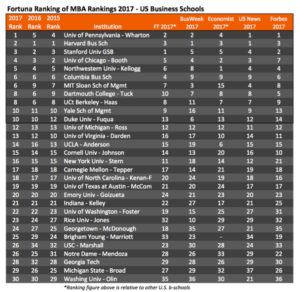Fortuna Admissions has compiled the results of the big five MBA rankings of the last 12 months to produce the Fortuna Ranking of MBA Rankings 2017.
How do the top business schools in the US perform when you combine these results? The big news is that Wharton has displaced Harvard at #1, based on its top ranking in Forbes and US News, and #2 in the FT and BusinessWeek.
Though HBS came out on top in the BusinessWeek ranking that published last week, and shared the #1 spot in US News, its position in the FT, Economist and Forbes means that when you take an average of the five major media rankings Wharton narrowly comes out ahead. That is quite a turnaround after several challenging years for the Philadelphia school, and will no doubt be met with relief from staff and alumni.
Columbia and Sloan share 6th place, which means that the M7 once again dominate the top 7 places after sharing last year with Tuck and Haas.
Further down the list, Michigan Ross and UCLA Anderson had a good year, with CMU Tepper also continuing its climb on the back of high demand for their tech-savvy graduates. Georgetown, BYU Marriott, USC Marshall and Georgia Tech also saw major gains.

Methodology
Only US business schools are ranked by all five major media rankings. Fortuna Admissions has calculated their overall performance by looking at each ranking position compared to other US schools, and taking an average of those results.
In the case of the FT and Economist rankings, if a US business school ranked #15 in the overall FT ranking and #32 in the overall Economist ranking, but among US business schools was #9 in the FT and #15 in The Economist, then the relative US regional figure was used for the calculation, and added to those of BusinessWeek, Forbes and US News, before dividing by the number of rankings to achieve an average score.
Candidates should remember that this is not scientific approach, and there is no attempt to give greater weight to one ranking over another. Each ranking uses a different methodology and measures different things with the inherent limitations of each assessment, so doing particularly well in one ranking and less well in another is reflected in the overall average score.
We have compiled the Fortuna Ranking of MBA Rankings since 2011 to show how the top business schools perform across all five of the major MBA rankings.
View how top business schools fared over the last several years:
US SCHOOLS
- Ranking of MBA Rankings 2016
- Ranking of MBA Rankings 2015
- Ranking of MBA Rankings 2014
- Ranking of MBA Rankings 2013
- Ranking of MBA Rankings 2012
- Ranking of MBA Rankings 2011
EUROPEAN SCHOOLS
- Ranking of MBA Rankings 2014
- Ranking of MBA Rankings 2013
- Ranking of MBA Rankings 2012
- Ranking of MBA Rankings 2011
You can read more rankings analysis in my related piece for Forbes, Wharton Outshines Harvard In The Ranking of MBA Rankings 2017.
Matt Symonds is Co-founder and Director of Fortuna Admissions, and bestselling author of Getting the MBA Admissions Edge, sponsored by McKinsey, Goldman Sachs, BCG and Bain. He co-produces the CentreCourt MBA Festival and writes about the MBA for Forbes, The Economist, BusinessWeek, the BBC, and AméricaEconomia.





